英语诗歌的欣赏教学文案
- 格式:doc
- 大小:31.50 KB
- 文档页数:12
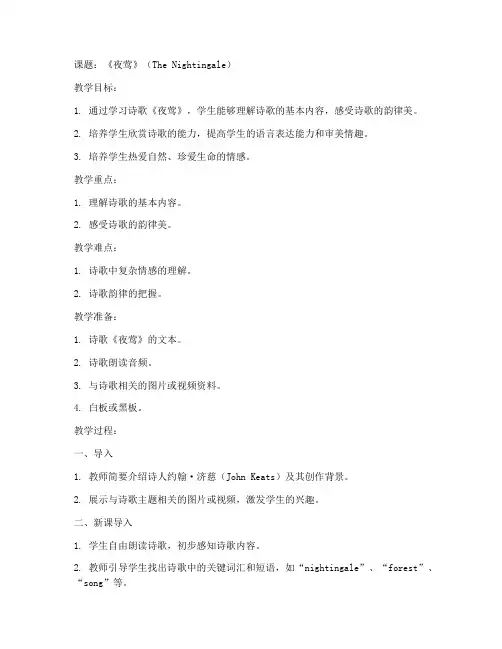
课题:《夜莺》(The Nightingale)教学目标:1. 通过学习诗歌《夜莺》,学生能够理解诗歌的基本内容,感受诗歌的韵律美。
2. 培养学生欣赏诗歌的能力,提高学生的语言表达能力和审美情趣。
3. 培养学生热爱自然、珍爱生命的情感。
教学重点:1. 理解诗歌的基本内容。
2. 感受诗歌的韵律美。
教学难点:1. 诗歌中复杂情感的理解。
2. 诗歌韵律的把握。
教学准备:1. 诗歌《夜莺》的文本。
2. 诗歌朗读音频。
3. 与诗歌相关的图片或视频资料。
4. 白板或黑板。
教学过程:一、导入1. 教师简要介绍诗人约翰·济慈(John Keats)及其创作背景。
2. 展示与诗歌主题相关的图片或视频,激发学生的兴趣。
二、新课导入1. 学生自由朗读诗歌,初步感知诗歌内容。
2. 教师引导学生找出诗歌中的关键词汇和短语,如“nightingale”、“forest”、“song”等。
三、诗歌分析1. 教师引导学生分析诗歌的结构,如诗歌的节奏、韵律等。
2. 学生分小组讨论,探讨诗歌中的意象和象征意义。
3. 教师总结小组讨论结果,并分享自己的理解。
四、诗歌朗读1. 教师示范朗读诗歌,学生跟随朗读。
2. 学生分组进行诗歌朗读比赛,提高学生的朗读兴趣。
五、诗歌创作1. 教师引导学生根据诗歌内容,创作自己的短诗。
2. 学生展示自己的作品,教师给予评价和指导。
六、总结与反思1. 教师总结本节课的学习内容,强调诗歌的韵律美和情感表达。
2. 学生分享自己的学习心得,教师进行点评。
教学评价:1. 学生对诗歌内容的理解程度。
2. 学生在诗歌朗读和创作中的表现。
3. 学生对诗歌韵律的把握能力。
教学延伸:1. 组织学生观看与诗歌相关的电影或纪录片。
2. 开展诗歌朗诵比赛或诗歌创作比赛。
板书设计:《夜莺》作者:约翰·济慈主题:自然之美、生命之赞内容:描述夜莺在森林中歌唱的情景,表达对自然的热爱和生命的赞颂。
韵律:抑扬顿挫,富有节奏感。
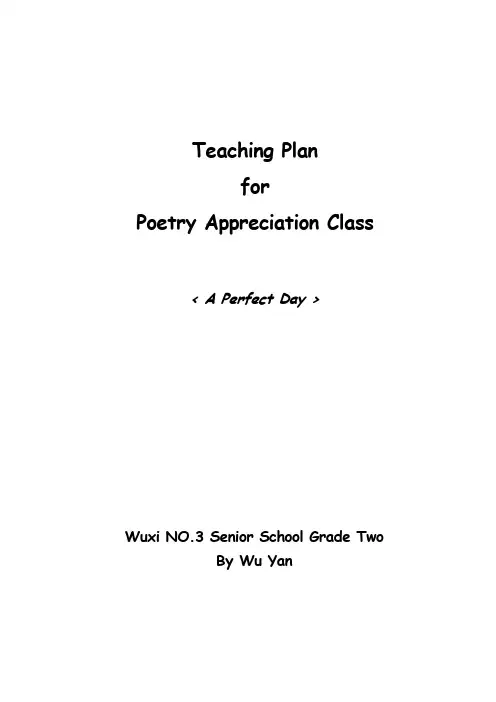
Teaching PlanforPoetry Appreciation Class< A Perfect Day >Wuxi NO.3 Senior School Grade TwoBy Wu YanA Perfect DayWhen you come to the end of a perfect day, And you sit alone with your thought,While the bells ring out with a carol gay, For the joy that the day has broughtDo you think what the end of a perfect day Can mean to a tired heart,When the sun goes down with a flaming ray, And the dear friends have to part?Well, this is the end of a perfect day, Near the end a journey too;But it leaves a thought that is big and strong, with a wish that is kind and true.For memory has painted this perfect day, With colors that never fade,And we find at the end of a perfect day, The soul of a friend we’ve made英语诗歌鉴赏课教学设计教学目标:知识目标:学生感受英语诗歌及英语语言的优美,掌握英语诗歌中出现的感情基调、体裁、意象和韵脚等。
能力目标:能够正确理解和分析诗歌,完整表述诗歌内容。
情感目标:加强合作精神的培养及一定的诗歌鉴赏能力。

初中英文诗歌的教案设计一、教学目标1. 知识目标:(1)学生能够理解并朗读所学的英文诗歌;(2)学生能够掌握诗歌中的重点词汇和短语;(3)学生能够理解诗歌的基本意义和情感表达。
2. 能力目标:(1)学生能够通过朗读和背诵,提高口语表达能力;(2)学生能够通过诗歌的学习,提高阅读理解和文学鉴赏能力;(3)学生能够运用所学词汇和短语,创作简单的英文诗歌。
3. 情感目标:(1)学生能够体验诗歌带来的美的享受;(2)学生能够激发对英语诗歌的兴趣和爱好;(3)学生能够培养合作和分享的良好学习态度。
二、教学内容1. 诗歌选材:选择一首适合初中生水平的英文诗歌,如Robert Louis Stevenson的"My Shadow"。
2. 诗歌内容:这首诗歌描述了作者和他的影子之间的互动,以及他对影子的喜爱和好奇。
诗歌中运用了生动的描绘和想象,表达了童真和欢乐的情感。
三、教学步骤1. 导入(5分钟)(1)教师通过展示一幅有关影子的图片,引导学生思考和讨论他们对自己的影子的看法和经历。
(2)教师简要介绍诗人Robert Louis Stevenson和他的诗歌创作背景。
2. 诗歌学习(15分钟)(1)教师逐句朗读诗歌,学生跟随朗读,注意语音语调和节奏的掌握。
(2)教师解释诗歌中的生词和短语,帮助学生理解诗歌内容。
(3)教师引导学生分析诗歌的结构和韵律,如押韵、重复等修辞手法。
3. 朗读和背诵(10分钟)(1)学生分组进行诗歌的朗读,注意语音语调和情感的传达。
(2)教师选取几位学生进行诗歌背诵,鼓励他们大胆表现自己。
4. 诗歌鉴赏(10分钟)(1)教师引导学生从情感、形象、主题等方面对诗歌进行分析和讨论。
(2)学生分享自己对诗歌的感受和理解,教师给予评价和指导。
5. 创作练习(10分钟)(1)教师提供一些关键词和短语,引导学生运用所学创作自己的英文诗歌。
(2)学生进行诗歌创作,教师巡回指导并提供反馈。
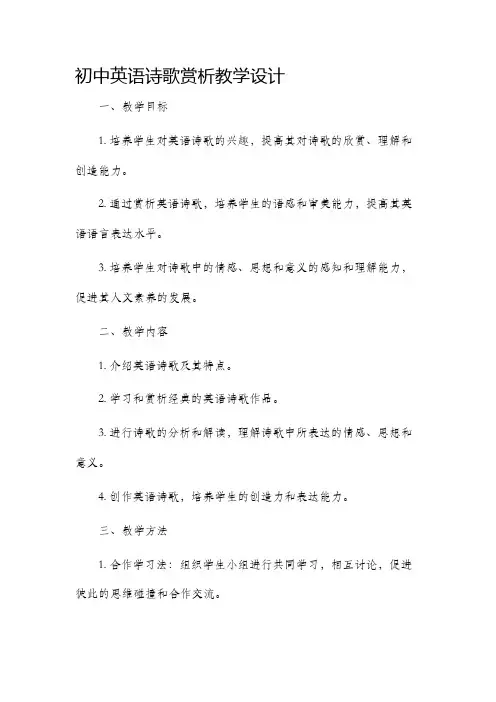
初中英语诗歌赏析教学设计一、教学目标1. 培养学生对英语诗歌的兴趣,提高其对诗歌的欣赏、理解和创造能力。
2. 通过赏析英语诗歌,培养学生的语感和审美能力,提高其英语语言表达水平。
3. 培养学生对诗歌中的情感、思想和意义的感知和理解能力,促进其人文素养的发展。
二、教学内容1. 介绍英语诗歌及其特点。
2. 学习和赏析经典的英语诗歌作品。
3. 进行诗歌的分析和解读,理解诗歌中所表达的情感、思想和意义。
4. 创作英语诗歌,培养学生的创造力和表达能力。
三、教学方法1. 合作学习法:组织学生小组进行共同学习,相互讨论,促进彼此的思维碰撞和合作交流。
2. 案例分析法:通过分析经典的英语诗歌作品,引导学生从不同的角度去理解和解读诗歌。
3. 制作诗歌赏析手册:引导学生制作个人的诗歌赏析手册,记录学习过程中的心得体会和赏析思路。
四、教学过程1. 介绍英语诗歌及其特点(20分钟)(1)教师简要介绍英语诗歌的定义和特点,如押韵、韵律、节奏等。
(2)展示几首简单的英语诗歌,让学生感受其独特之处。
2. 学习和赏析经典的英语诗歌作品(40分钟)(1)选择一首经典的英语诗歌进行学习和赏析,如William Shakespeare的Sonnet 18。
(2)教师分析诗歌的结构、表达方式和意义,学生跟随教师一起读诗,并逐句解读。
(3)学生小组合作,讨论诗歌中所表达的情感、思想和意义。
3. 进行诗歌的分析和解读(30分钟)(1)教师为学生提供更多的英语诗歌作品,要求学生进行分析和解读,理解诗歌中的意义和感情表达。
(2)鼓励学生从不同的角度出发,探讨诗歌中的隐含含义和象征意义。
4. 创作英语诗歌(30分钟)(1)教师给学生提供一些诗歌创作的技巧和示范,如押韵和运用修辞格。
(2)学生自主创作英语诗歌,可以以自己的经历或感受为主题,发挥想象力和创造力。
5. 总结和展示(10分钟)(1)学生展示自己的诗歌作品,并分享创作的过程和心得体会。
(2)教师对学生的表现给予肯定和评价,指导学生如何提高诗歌的创作和表达能力。
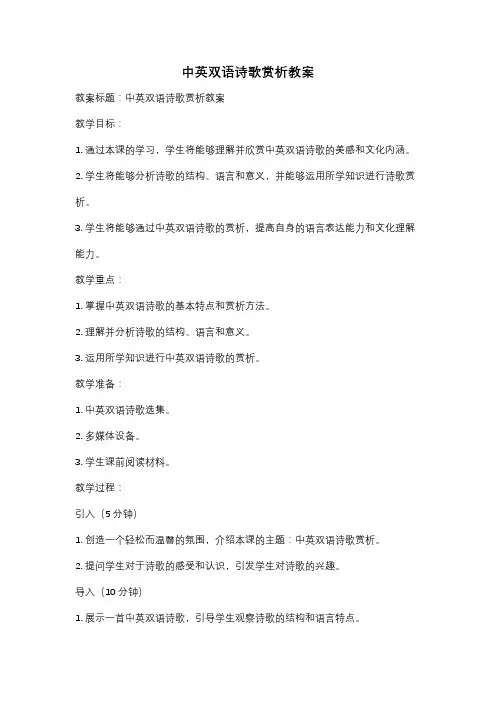
中英双语诗歌赏析教案教案标题:中英双语诗歌赏析教案教学目标:1. 通过本课的学习,学生将能够理解并欣赏中英双语诗歌的美感和文化内涵。
2. 学生将能够分析诗歌的结构、语言和意义,并能够运用所学知识进行诗歌赏析。
3. 学生将能够通过中英双语诗歌的赏析,提高自身的语言表达能力和文化理解能力。
教学重点:1. 掌握中英双语诗歌的基本特点和赏析方法。
2. 理解并分析诗歌的结构、语言和意义。
3. 运用所学知识进行中英双语诗歌的赏析。
教学准备:1. 中英双语诗歌选集。
2. 多媒体设备。
3. 学生课前阅读材料。
教学过程:引入(5分钟)1. 创造一个轻松而温馨的氛围,介绍本课的主题:中英双语诗歌赏析。
2. 提问学生对于诗歌的感受和认识,引发学生对诗歌的兴趣。
导入(10分钟)1. 展示一首中英双语诗歌,引导学生观察诗歌的结构和语言特点。
2. 通过简单的讲解,介绍中英双语诗歌的基本特点和赏析方法。
正文(30分钟)1. 分发选定的中英双语诗歌,让学生阅读和理解诗歌的内容。
2. 引导学生分析诗歌的结构、语言和意义,例如韵律、押韵、修辞手法等。
3. 鼓励学生表达对诗歌的个人理解和感受,可以进行小组讨论或展示。
拓展(10分钟)1. 展示更多中英双语诗歌的例子,让学生进一步感受诗歌的美感和文化内涵。
2. 引导学生思考诗歌与文化的关系,并讨论不同文化背景下诗歌的表达方式和主题。
总结(5分钟)1. 总结本课的学习内容,强调中英双语诗歌赏析的重要性和意义。
2. 鼓励学生继续阅读和欣赏中英双语诗歌,提高自身的语言表达能力和文化理解能力。
作业布置:要求学生选择一首中英双语诗歌,进行赏析并写下自己的感受和理解。
教学反思:本节课通过引入中英双语诗歌赏析的主题,激发了学生对诗歌的兴趣。
通过分析诗歌的结构、语言和意义,学生能够更好地理解和欣赏诗歌的美感和文化内涵。
通过小组讨论和展示,学生能够提高自身的语言表达能力和文化理解能力。
同时,通过作业的布置,学生能够进一步加深对中英双语诗歌的理解和赏析能力。
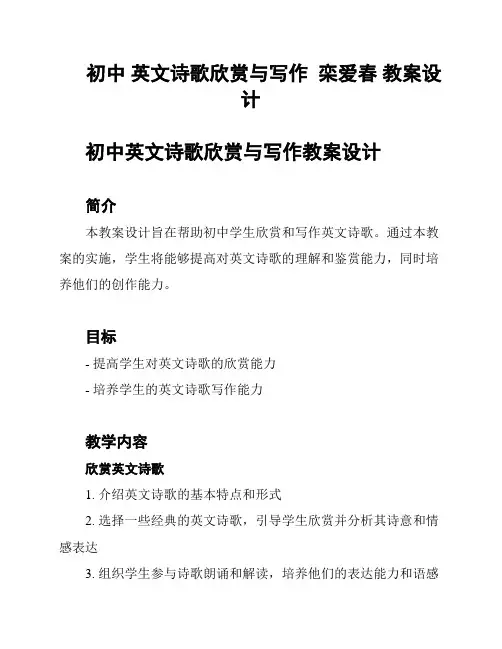
初中英文诗歌欣赏与写作栾爱春教案设计初中英文诗歌欣赏与写作教案设计简介本教案设计旨在帮助初中学生欣赏和写作英文诗歌。
通过本教案的实施,学生将能够提高对英文诗歌的理解和鉴赏能力,同时培养他们的创作能力。
目标- 提高学生对英文诗歌的欣赏能力- 培养学生的英文诗歌写作能力教学内容欣赏英文诗歌1. 介绍英文诗歌的基本特点和形式2. 选择一些经典的英文诗歌,引导学生欣赏并分析其诗意和情感表达3. 组织学生参与诗歌朗诵和解读,培养他们的表达能力和语感写作英文诗歌1. 引导学生了解英文诗歌的基本结构和写作技巧2. 提供一些写作诗歌的主题和创作素材,激发学生的创作灵感3. 指导学生通过写作练,逐步提高他们的诗歌创作水平4. 组织学生互相分享和评价诗歌作品,促进他们的相互研究和进步教学步骤1. 简要介绍英文诗歌的特点和形式,引发学生对诗歌的兴趣2. 挑选一些经典的英文诗歌,学生进行朗诵和分析,探讨其中的诗意和情感表达3. 引导学生了解英文诗歌的结构和写作技巧,通过练提高他们的创作能力4. 组织学生进行诗歌创作,鼓励他们表达自己的思想和情感5. 学生相互分享和评价诗歌作品,互相研究和进步6. 总结课程内容,鼓励学生继续欣赏和写作英文诗歌延伸活动1. 组织学生参加英文诗歌朗诵比赛,展示他们的才艺与创作成果2. 邀请专业诗人或作家给学生讲解关于英文诗歌创作的经验和技巧教学评估1. 学生对经典英文诗歌的朗诵和分析表达能力2. 学生的诗歌创作作品和创造力3. 学生在课堂上的参与和表现4. 学生对诗歌欣赏和写作的兴趣和热情参考资源- Brown, J. (2010). A Collection of Classic English Poetry. London: Oxford University Press.- Smith, L. (2012). Writing Poetry: A Guide for Beginners. New York: Penguin Books.以上是初中英文诗歌欣赏与写作教案设计的内容,希望能帮助到您。
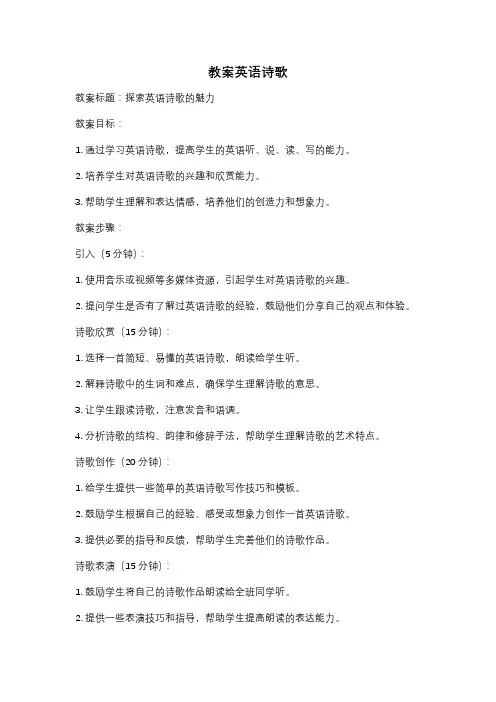
教案英语诗歌教案标题:探索英语诗歌的魅力教案目标:1. 通过学习英语诗歌,提高学生的英语听、说、读、写的能力。
2. 培养学生对英语诗歌的兴趣和欣赏能力。
3. 帮助学生理解和表达情感,培养他们的创造力和想象力。
教案步骤:引入(5分钟):1. 使用音乐或视频等多媒体资源,引起学生对英语诗歌的兴趣。
2. 提问学生是否有了解过英语诗歌的经验,鼓励他们分享自己的观点和体验。
诗歌欣赏(15分钟):1. 选择一首简短、易懂的英语诗歌,朗读给学生听。
2. 解释诗歌中的生词和难点,确保学生理解诗歌的意思。
3. 让学生跟读诗歌,注意发音和语调。
4. 分析诗歌的结构、韵律和修辞手法,帮助学生理解诗歌的艺术特点。
诗歌创作(20分钟):1. 给学生提供一些简单的英语诗歌写作技巧和模板。
2. 鼓励学生根据自己的经验、感受或想象力创作一首英语诗歌。
3. 提供必要的指导和反馈,帮助学生完善他们的诗歌作品。
诗歌表演(15分钟):1. 鼓励学生将自己的诗歌作品朗读给全班同学听。
2. 提供一些表演技巧和指导,帮助学生提高朗读的表达能力。
3. 通过表演,让学生展示他们对诗歌的理解和表达能力。
总结(5分钟):1. 回顾本节课所学的内容和经验。
2. 鼓励学生分享他们对英语诗歌的新的认识和体验。
3. 引导学生思考如何在日常生活中继续欣赏和创作英语诗歌。
教案扩展:1. 鼓励学生在课后继续阅读和欣赏英语诗歌,可以推荐一些适合他们的经典诗歌作品。
2. 组织学生参加诗歌朗诵比赛或创作比赛,激发他们的学习兴趣和竞争意识。
3. 配合其他教材和教学资源,设计更多与英语诗歌相关的活动,如诗歌翻译、诗歌分析等。
教案评估:1. 观察学生在课堂上的参与度和表现,包括对诗歌的理解和表达能力。
2. 收集学生的诗歌作品,评估他们的创作能力和语言运用水平。
3. 与学生进行个别或小组交流,了解他们对本节课的反馈和收获。
教案注意事项:1. 根据学生的年龄和英语水平,选择适当的英语诗歌。
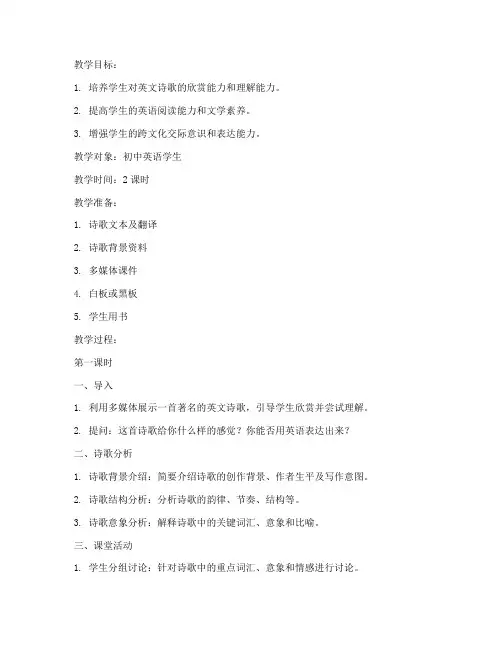
教学目标:1. 培养学生对英文诗歌的欣赏能力和理解能力。
2. 提高学生的英语阅读能力和文学素养。
3. 增强学生的跨文化交际意识和表达能力。
教学对象:初中英语学生教学时间:2课时教学准备:1. 诗歌文本及翻译2. 诗歌背景资料3. 多媒体课件4. 白板或黑板5. 学生用书教学过程:第一课时一、导入1. 利用多媒体展示一首著名的英文诗歌,引导学生欣赏并尝试理解。
2. 提问:这首诗歌给你什么样的感觉?你能否用英语表达出来?二、诗歌分析1. 诗歌背景介绍:简要介绍诗歌的创作背景、作者生平及写作意图。
2. 诗歌结构分析:分析诗歌的韵律、节奏、结构等。
3. 诗歌意象分析:解释诗歌中的关键词汇、意象和比喻。
三、课堂活动1. 学生分组讨论:针对诗歌中的重点词汇、意象和情感进行讨论。
2. 学生自由发挥:用自己的语言复述诗歌内容,或者创作一段与诗歌主题相关的短文。
四、课堂小结1. 教师总结诗歌的重点内容和特点。
2. 学生分享自己的理解和感受。
第二课时一、复习导入1. 回顾上一节课的内容,提问:你们还记得上一首诗歌的作者和主要内容吗?2. 学生分享自己的创作或复述。
二、诗歌拓展1. 引导学生阅读其他诗歌作品,比较不同诗歌的特点和风格。
2. 学生自由选择一首诗歌进行朗读和分享。
三、课堂活动1. 学生分组进行诗歌创作比赛,以诗歌的形式表达自己的情感或观点。
2. 学生互相评价作品,并提出改进建议。
四、课堂小结1. 教师总结本节课的收获,强调诗歌欣赏的重要性。
2. 学生分享自己的创作体验和感受。
教学评价:1. 观察学生在课堂活动中的参与程度和表现。
2. 评估学生的诗歌理解和创作能力。
3. 收集学生作品,进行点评和反馈。
教学反思:1. 教师应关注学生的个体差异,提供个性化的指导。
2. 在教学中注重培养学生的创新思维和表达能力。
3. 结合学生的实际情况,适时调整教学策略,提高教学效果。
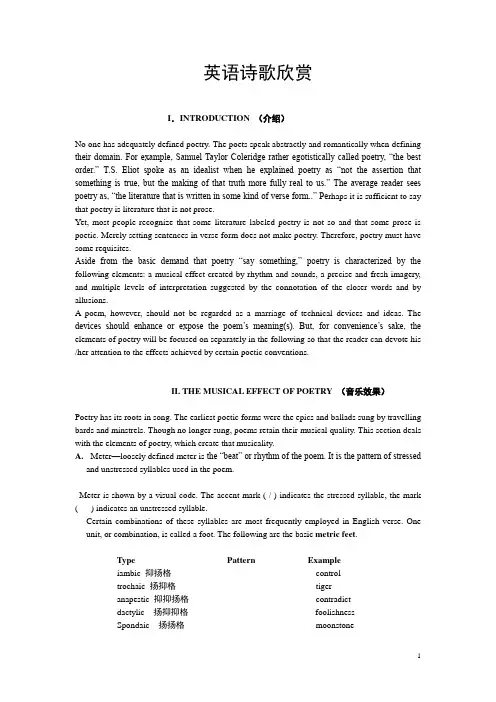
英语诗歌欣赏I.INTRODUCTION (介绍)No one has adequately defined poetry. The poets speak abstractly and romantically when defining their domain. For example, Samuel Taylor Coleridge rather egotistically called poetry, ―the best order.‖T.S. Eliot spoke as an idealist when he explained poetry as ―not the assertion that something is true, but the making of that truth more fully real to us.‖ The average reader sees poetry as, ―the literature that is written in some kind of verse form..‖ Pe rhaps it is sufficient to say that poetry is literature that is not prose.Yet, most people recognize that some literature labeled poetry is not so and that some prose is poetic. Merely setting sentences in verse form does not make poetry. Therefore, poetry must have some requisites.Aside from the basic demand that poetry ―say something,‖ poetry is characterized by the following elements: a musical effect created by rhythm and sounds, a precise and fresh imagery, and multiple levels of interpretation suggested by the connotation of the closer words and by allusions.A poem, however, should not be regarded as a marriage of technical devices and ideas. The devices should enhance or expose the poem‘s meaning(s). But, for convenience‘s sake, the elements of poetry will be focused on separately in the following so that the reader can devote his /her attention to the effects achieved by certain poetic conventions.II. THE MUSICAL EFFECT OF POETRY (音乐效果)Poetry has its roots in song. The earliest poetic forms were the epics and ballads sung by travelling bards and minstrels. Though no longer sung, poems retain their musical quality. This section deals with the elements of poetry, which create that musicality.A.Meter—loosely defined meter is the ―beat‖ or rhythm of the poem. It is the pattern of stressedand unstressed syllables used in the poem.Meter is shown by a visual code. The accent mark ( / ) indicates the stressed syllable, the mark ( ) indicates an unstressed syllable.Certain combinations of these syllables are most frequently employed in English verse. One unit, or combination, is called a foot. The following are the basic metric feet.Type Pattern Exampleiambic 抑扬格controltrochaic 扬抑格tigeranapestic 抑抑扬格contradictdactylic 扬抑抑格foolishnessSpondaic 扬扬格moonstoneThus, the number of syllables in a line is relevant, but the number of stresses is more important in determining the pace of the poem. The more stresses in a line the more weighty and slow-moving is it. Alternately, a preponderance of unstressed syllables gives lightness and guideness to a poem. These metrical feet build the rhythm of the poem. When a line of poetry is divided into metrical feet, the line is named after the number of feet contained therein. The types of lines are:Monometer: 单音步one foot per lineDimeter: 双音步two feet per lineTrimeter: 三音步three feet per lineTetrameter: 四音步four feet per linePentameter: 五音步five feet per lineHexameter: 六音步six feet per lineHeptameter: 七音步seven feet per lineOctometer: 八音步eight feet per line(Rarely does a line contain eight feet or more.)Most poems are not written rigidly in one metric pattern. Monotony would ensure otherwise. The variety of a new foot interspersed among a set of regular feet can call attention to the words of those irregular feet or can obscure unimportant words.Meter is also influenced by pauses. Most metrical poetry evolves into a pattern of pauses at lines‘ends. A caesura(停顿), or pause within a line (usually indicated by a mark of punctuation), can alter, usually slow down, the meter. An enjambement(跨行), or run-on line, can speed up the flow of the poem.Caesura—Be that as may be, she was in their song.(Robert Fro st, ―Never Again Would Birds‘ Song Be the Same‖) Enjambement—This living hand, now warm and capableOf earnest grasping,…(Keats, ―This living hand,‖)B.Types of Rhyme 押韵种类Rhyme—(or rime)--the repetition of similar ( or duplicate) sounds at regular intervals. (Usually this repetition occurs at the ends of lines.)1.End rhyme (脚韵、尾韵)---rhyme found at the ends of verse lines.Ex: Thou ill-formed offspring of my feeble brain,Who after birth did‘st by my side remain,(Anne Bradstreet, ―The Author to Her Book‖)End rhyme follows, usually, a pattern that is repeated throughout the stanzas of the poem.The rhyme scheme(韵式)is denoted by small case letters, each letter representing aspecific rhyme-sound. Once a pattern for one stanza is established the analyzer need not continue with his lettering. Thus a poem following a scheme of abac has the first and third lines only of each stanza rhyming.2.Internal rhyme (行间韵、腹韵)---this is rhyme contained within a line of verse.Ex: ―The long light shakes across the lakes‖(Tennyson, ―Blow, Bugle, Blow‖)3.Slant rhymes(斜韵)---an inexact rhyme where the final consonant sounds are the same butthe vowel sounds are different.Ex: ―And by his smile, I knew that sullen hall,By his dead smile I knew we stood in Hell.‖(Wilfred Owen, ―Strange Meeting‖)(Also called ―near rhyme,‖ ―half rhyme,‖ or ―partial rhyme.‖)4.Eye rhyme(眼韵)---the rhyming of two words which lo ok as if they‘d rhyme, but do not,such as ―move‖ and ―love.‖5.Feminine rhyme(阴韵)---rhyme in which two consecutive syllables of the rhyme-wordsmatch. The first syllable carries the stress. Feminine rhyme adds lightness to a poem.Ex: We poets in our youth begin in gladness,But thereof come in the end despondency and madness.(Wordsworth, ―Resolution and Independence‖)6.Masculine rhyme-(阳韵)--the rhyme of one-syllable words or, in the case of words of morethan one syllable, the rhyming of stressed final syllables.Ex: A sweet disorder in the dressKindles in clothes a wantonness.(Robert Herrick, ―Delight in Disorder‖)C.Other Musical Devices: the use of sound1.Assonance(谐元音、押元音)—the repetition of two or more vowel sounds within a line.Ex: Our echoes roll from soul to soul.2.Consonance(谐辅音、押辅音)—the repetition of two or more consonant sounds withina line.Ex: The splendor falls on castle wallsAnd snowy summit old in story;(Tennyson, ―The splendor falls…‖)3.Alliteration(头韵)—repetition of two or more initial consonants sounds in words withina line.Ex: He clasps the crag with crooked hands(Tennyson, ―The Eagle‖)4.Onomatopoeia(拟声)—the use of a word whose sound suggests its meaning or whichimitates the sound made by an object or creature.Ex: I heard a fly buzz when I died,(Emily Dickinson)The moan of doves in immemorial elms,And murmuring of innumerable bees.(Tennyson, ―Come down, O maid‖)5.Euphony and Cacophony(和谐与失谐)—euphony is the use of harmonies, melodioussounds in a poemCacophony is the use of harsh, irritating sounds.D. Stanzas诗节Stanzas are the ―paragraphs‖ of poems. Stanzas can range in length from two lines to anunlimited number of lines. However, few poems use stanzas of more than eight lines. For convenience of reference, the stanzas have been titled according to line length.Number of Lines in the stanza Stanza Name2Couplet3Tercet4Quatrain5Cinquain6Sestet7Septet8Octabe (octet)For stanzas of 9 or mo re lines, merely refer to them as ―nine-line stanzas,‖ etc.Robert Frost(1874-1963)1. The Span of LifeThe old dog barks backward without getting up.I can remember when he was a pup.Robert Herrick(1591-1674)2. Upon Julia’s VoiceSo smooth, so sweet, so silv‘ry is thy voice,As, could they hear, the Damned would make no noise,But listen to thee (walking in thy chamber)Melting melodious words to Lutes of AmberWalter de la Mare(1873-1956)3. SilverSlowly, silently, now the moonWalks the night in her silver shoon;This way, and that she peers, and seesSilver fruit upon silver trees.. . .Alfred Tennyson(1809-1892)4. The Eagle(A Fragment)He clasps the crag with crooked hands;Close to the sun in lonely lands,Ringed with the azure world, he stands.The wrinkled sea beneath him crawls:He watches from his mountains walls,And like a thunderbolt he falls. Robert Herrick(1591-1674)5. Upon His Departure HenceThus IPass byAnd die,As one,Unknown,And gone:I‘m madeA shade,And laidI‘th grave,There haveMy cave.Where tellI dwell,Farewell.Thomas Hardy(1840-1928)6. The RobinWhen I / descendTowards / their brinkI stand, / and look,And stoop, / and drink,And bathe / my wings,And chink / and prink.…Lionel Johnson7.Alone / he rides,/ alone,The fair / and fa / tal king:Dark night / is all / his own,The strange / and sol / emn thing.. . .Thomas Nashe(1567- 1601)8. SpringSpring, the sweet Spring, is the year‘s pleasant king;Then bloom each thing, then maids dance in a ring,Cold doth not sting, the pretty birds do sing,Cuckoo, jug-jug, pu-we, to-witta-woo!The palm and may make country house gay,Lambs frisk and play, the shepherds pipe all day,And we hear aye birds tune this merry lay,Cuckoo, jug-jug, pu-we, to-witta-woo!The fields breathe sweet, the daisies kiss our feet,Young lovers meet, old wives a-sunning sit,In every street these tunes our ears do greet,Cuckoo, jug-jug, pu-we, to-witta-woo!Spring! the sweet Spring!III. IMAGERY (意象)Imagery is the use of descriptive language to re-create sensory experiences. An image is a verbal Picture of an object, action, abstract idea, or sensation. Images often are created by utilizing figures of speech. These are ways of making an idea or picture come clearer into focus by relatingthe idea or experience to another that may be more familiar to the reader.A.S ome Figures of Speech (修辞格)1.Metaphor—a comparison of unlike items. This comparison is directly stated as in ―All the world‘s a stage‖--ShakespeareThe metaphor is a device in which one object is substituted for another, or an idea is identified by a concrete object.2.Simile—the direct comparison of two unlike items, using the words ―like‖ or ―as‖ to complete the comparison.Helen, thy beauty is to meLike those Nicean barks of yore,(Poe, ―To Helen‖)3.Personification—the figure of speech which assigns human qualities to inanimate objects or abstractions.Because I could not stop for Death—He kindly stopped for me—(Emily Dickinson)4.Metonymy—literally ―a change of name;‖ a fi gure of speech in which the name of some object or idea is substituted for another name to which it has some relation (as a cause for an effect, a writer for his work).5. Synecdoche—a figure of speech in which a part of an object is used to represent the wholeobject or idea.6. Apostrophe—a figure of speech in which an inanimate object, a dead person, or an abstractidea is addressed directly. (The object or idea is thereby personified.)Hail to thee, blithe spirit!Bird thou never went—(Percy Bysshe Shelley, ―To a Skylark‖)7. Hyperbole—an exaggeration used to give emphasisThe brain is wider than the sky—(Emily Dickinson)8. Paradox—a statement which is an apparent contradiction contains a basis of truth which,when considered , reconciles the seeming opposites.I‘m nobody! Who are you?(Emily Dickinson)My youth is spent, and yet I am not old,(oxymoron is a poetical paradox—―O loving hate!‖)9. Pun—a play on words; this can be a wordplay on a word with two different meaningsor a play on the similarity of meanings in two words spelled differently but pronounced the same or a play on two words pronounced somewhat alike but differing in meanings.Robert Burns (1759-1796)9. A Red, Red RoseO my luve is like a red, red rose,That‘s newly sprung in June;O my luve is like the melodieThat‘s sweetly played in tune.As fair thou art, my bonnie lass,So deep in luve am I;And I will luve thee still, my dear,Till a‘ the seas gang dry.Till a‘ the seas gang dry, my dear,And the rocks melt wi‘ the sun;And I will luve thee still, my dear,While the sands o‘ life shall run.And fare thee weel, my only luve,And fare thee weel a while;And I will come again, my luve,Tho‘ it were ten thousand mile!Thomas MacDonagh10.Love Is Cruel, Love Is SweetLove is cruel, love is sweet, ---Cruel sweet,Lovers sigh till lovers meet,Sigh and meet ---Sigh and meet, and sigh again---Cruel sweet! O sweetest pain!Love is blind --- but love is sly,Blind and sly.Thoughts are bold, but words are shy ---Bold and shy ---Bold and shy, and bold again ---Sweet is boldness, --- shyness pain. William Blake (1757-1827)11. To See a World in a Grain of SandTo see a world in a grain of sandAnd a heaven in a wild flower,Hold infinity in the palm of your handAnd eternity in an hour.Charles Simic(1938-)12. WatermelonsGreen BuddhasOn the fruit stand.We eat the smileAnd spit out the teeth.Carl Sandburg (1878-1967)13.FogThe fog comeson little cat feet.It sits lookingover harbor and cityon silent haunchesand then moves onGregory Orr (1947-)14.All MorningAll morning the dream lingers.I am like thick grassin a meadow, stillsoaked with dew at noon.James Stephens15. The WindThe wind stood up and gave a shout.He whistled on his fingers andKicked the withered leaves aboutAnd thumped the branches with his handAnd said he‘d kill and kill and kill,And so he will and so he will.Langston Hughes(1902-1967)16. DreamsHold fast to dreamsFor if dreams dieLife is a broken-winged birdThat cannot fly.Hold fast to dreamsFor when dreams goLife is a barren fieldFrozen with snow..Emily Dickinson (1830-1886)17. ―Hope‖ Is the Thing with Feathers―Hope‖ is the thing with feathers –That perches in the soul –And sings the tune without the words –And never stops –at all –And sweetest – in the Gale – is heard –And sore must be the storm –That could abash the little BirdThat kept so many warm –I‘ve heard it in the chillest land –And on the strangest sea –Yet, never, in extremity,It asked a crumb – of Me.Percy Bysshe Shelly (1792-1822)18 Love’s PhilosophyThe fountains mingle with the riverAnd the rivers with the Ocean.The winds of Heaven mix for everWith a sweet emotion;Nothing in the world is single,All things by a law divineIn one another‘s being mingle ---Why not I with thine?See the mountains kiss high heavenAnd the waves clasp one another;No sister-flower would be forgivenIf it disdain‘d its brother:And the sunlight clasps the earth,And the moonbeams kiss the sea ---What are all these kissings worth,If thou kiss not me?.Edgar Allan Poe19. Annabel LeeIt was many and many a year ago,In a kingdom by the sea,That a maiden there lived whom you may knowBy the name of ANNABEL LEE;And this maiden she lived with no other thoughtThan to love and be loved by me.I was a child and she was a child,In this kingdom by the sea;But we loved with a love that was more than love—I and my ANNABEL LEE;With a love that the winged seraphs of heavenCoveted her and me.And this was the reason that, long ago,In this kingdom by the sea,A wind blew out of a cloud, chillingMy beautiful ANNABEL LEE;So that her highborn kinsmen cameAnd bore her away from me,To shut her up in a sepulchreIn this kingdom by the sea.The angels, not half so happy in heaven,Went envying her and me—Yes! –that was the reason ( as all men know,In this kingdom by the sea.)That the wind came out of the cloud by night,Chilling and killing my ANNABEL LEE.But our love it was stronger by far than the loveOf those who were older than we –Of many far wiser than we –And neither the angels in heaven above,Nor the demons down under the sea,Can ever dissever my soul from the soulOf the beautiful ANNABEL LEE:For the moon never beams without bringing me dreamsOf the beautiful ANNABEL LEE;And the stars never rise but I see the bright eyesOf the beautiful ANNABEL LEE;And so, all the night-tide, I lie down by the sideOf my darling, my darling, my life and my bride,In her sepulchre there by the sea—In her tomb by the sounding sea.B.SymbolismSymbolism is the use of an object, person, reason, animal or other concrete item torepresent an abstract idea of an emotion. A symbol does not have one stock meaning. A symbol can represent a summary of ideas or attitudes.Odysseus‘ journey to find his homeland after the Trojan War is symbolic of each man‘s quest to find his niche in society.―Home‖ frequently is a symbol for a safe place, a place where one fits it, or any of a numberof such related ideas.Robert Frost20. Stopping by Woods on a Snowy EveningWhose woods these are I think I know.His house is in the village though;He will not see me stopping hereTo watch his woods fill up with snow.My little horse must think it queerTo stop without a farmhouse nearBetween the woods and frozen lakeThe darkest evening of the year.He gives his harness bells a shakeTo ask if there is some mistake.The only other sound‘s the sweepOf easy wind and downy flake.The woods are lovely, dark, and deep.But I have promises to keep,And miles to go before I sleep,And miles to go before I sleep.Robert Frost21. The Road Not TakenTwo roads diverged in a yellow wood,And sorry I could not travel bothAnd be one traveler, long I stoodAnd looked down one as far as I couldTo where it bent in the undergrowth;Then took the other, as just as fair,And having perhaps the better claim,Because it was grassy and wanted wear;Though as for that the passing thereHad worn them really about the same.And both that morning equally layIn leaves no step had trodden black.Oh, I kept the first for another day!Yet knowing how way leads on to way,I doubted if I should ever come back.I shall be telling this with a sighSomewhere ages and ages hence:Two roads diverged in a wood, and I –I took the one less traveled by,And that has made all the difference.C.AllusionAn allusion is a reference to an outside event, person, or fact. Most allusion in pre-twentieth century poetry referred to events in people from classical Greek mythology or Bible. Most often in the twentieth century poets one finds allusions to current events or personages.Images can be suggested by the connotations of words. The denotation of a word is its literal meaning. The connotations of a word are those suggestions of additional meaning that are attached to a word. Thus ―home‖ denotes merely a place where one lives; it may connote warmth, love, shelter, or a number of other meanings..Edgar Allan Poe (1809-1849)22. To HelenHELEN, thy beauty is to meLike those Nicean barks of yore,That gently, o‘er a perfumed sea,The weary, wayworn wanderer boreTo his own native shore.On desperate seas long wont to roam,Thy hyacinth hair, thy classic face,Thy Naiad airs have brought me homeTo the glory that was Greece,And the grandeur that was Rome.Lo! in yon brilliant window niche,How statue-like I see thee stand,The agate lamp within thy hand!Ah, Psyche, from the regions whichAre Holy Land!.Robert Frost (1874-1963)23. Nothing Gold Can StayNature‘s first green is gold,Her hardest hue to hold.Her early leaf‘s a flower;But only so an hour.The leaf subsides to leaf.So Eden sank to grief,So dawn goes down to day.Nothing gold can stay.IV. THE TYPES OF POETRYA.The Lyric Poem 抒情诗A lyric poem is a poem of limited length, expressing the thoughts and feelings of a singlespeaker. The lyric has a regular metrical pattern and a regular rhyme scheme. It is characterized by its intensely personal tone and imagery.There are a number of more specific categories of lyrics.1.The elegy 挽歌—this is a dignified lyric poem lamenting the death of an individual ‗among all men‘.2.The ode 颂歌—this is a lyric poem of considerable length. The ode is serious in subject and formal in style.3.The sonnet 十四行诗—this is a lyric poem of fourteen lines which follow a designated rhyme scheme. The sonnet is written in iambic pentameter. The two basic types of sonnets are the Petrarchan 彼特拉克体(or Italian) and the Shakespearean 莎士比亚体(or English).The Petrarchan sonnet follows the rhyme schemea b b a a b b a c d e c d e ora b b a a b b a c d c c d cThe Petrarchan sonnet is divided into two sections, the octave (first eight lines) and the sestet (the final six lines). The octave usually proposes a question, develops a narrative, or delineates an idea. The accompanying sestet will answer the question, comment on the story, or countermand the idea. This thought-division is often signalled by an enjambement in line 9.The Shakespearean sonnet follows the rhyme schemea b a b c d c d e f e f g gThe Shakespearean sonnet‘s thought-division is a 4-4-4-2 plan. There are four sections—three quatrains and a final couplet. In the Shakespearean sonnet each quatrain deals with a different aspect of the subject and the couplet either summarizes the theme or makes a final, sometimes contradictory, comment.Two variations of these sonnets are the Miltonic and the Spenserian sonnets. John Milton followed the Petrarchan rhyme scheme, but made his sestet merely a continuation of his original octave, not an answer or comment to it. His unique sonnet has been utilized by a number of poets. Edmund Spenser‘s original sonnet rhyme scheme has been passed down to us also, although it has not been commonly used by anyone but Spenser.. Spenser followed the English thought-division of three quatrains and couplet. However, he altered the rhyme scheme to abab bcbc cdcd ee , thus linking the quatrains.The sonnet is a rigid form, imposing strict rules on its practitioners. Many poets have chosen to accept the challenge of the sonnet, calling upon their skills as poets.B.The Narrative Poem 叙事诗The narrative poem tells a story. This story can be simple or complicated, long or short. Often the story is non-dramatic, the events of the tale being arranged in mere chronological order not in a dramatic sequence building to a climax. Narrative verse is objective, rarely revealing any of the poet‘s philosophy. The narrative verse appears to come from the tales of an impartial narrator.1. The Ballad民谣Ballads are the traditional narrative songs, or poems. The traits of a ballad are:1) A ballad tells a story ; often the story is not fully developed. The ballad stsoryfrequently gives no motives for a character‘s actions. The story is usually tragic, focusing most likely on love or death.2) A ballad has simple meter, quite often very regular iambic or trochaic tetrameter.3)Because ballads are sing-songy, they often use nonsense syllables in refrain.4)Ballads utilize quite bit of repetition. Sometimes this repetition takes the form of arefrain , or chorus. Often a pattern is repeated; for example, in the old English ballad ―Lord Randall‖ the pattern is a series of similarly phrased questions and answers.Sometimes the repetition is incremental, that is a line or lines is/are repeated but with avariation on that line.5)Ballads deal with local history, folklore, or escapades of a hero.6)Ballads rhyme. The traditional ballad stanza is a quatrain which rhymes abcb.7)Ballads frequently are written in dialect.8)Superstitions, or the supernatural, often play a role on ballads.Modern ballads adhere less strictly to the content requirements of a ballad, utilizing the format merely to tell a folksy tale.2. The epic 史诗The epic is a lengthy narrative poem which deals with a hero, a man of historical or legendary significance. The epic is formal in style. It follows a fairly well-established format. The poet opens with a question, an inquiry into the tale of some great personage or event. The answer to the question follows as the narrative of the epic. During the singing of the hero‘s praises the poet usually catalogues and describes the other main characters and their backgrounds. Deeds of valor are recounted. Battles usually are the main sources of action.Epics are of two types—the folk and the art epic. The folk epic is one that was born of the oral tradition, the tale being handed down from generation to generation sung by travelling bards. Finally some poet wrote the folk epic down. The Anglo-Saxon Beowulf and the Greek Odyssey are examples of folk epics. The art epic are more tightly organized than many of the folk epics. Dante‘s Divine Comedy is an example of art epics.C.Blank Verse 无韵诗、素体诗Blank verse is the term applied to poetry written in unrhymed iambic pentameter. This type of verse was first employed by the English poet Surrey. It is reasonable for an English poet to adopt this mode since English, unlike many of the Romance languages, is a language of such a variety of sounds that rhymes are not easily come by. Many English words rhyme with no others.Blank verse was popularized by Elizabethan playwrights, notably Christopher Marlowe and William Shakespeare. These Elizabethan poets found that blank verse solved a problem of theirs as dramatists. Since poetry was the only accepted mode for writing anything but instructive essays, the Elizabethan playwrights had to struggle with creating reasonable dialogue in verse. The limiting nature of rhyme made the task difficult. The playwright had two options. He could create good poetry, but his dramatic style suffered. Or he could pen a play with a cohesive plot and meaningful dialogue, but in shoddy poetry. Blank verse offered these sixteenth century dramatist a compromise. The verse is regular in meter, but not confined by the convention of rhyme. Also, the elimination of rhyme released much of the serious dialogue from the musicality, cuteness, or lightness of rhymed verse.In later centuries blank verse has been used in a variety of poems. Quite often a poet who iscontemplating a serious subject will write in blank verse. Since spoken English has been scanned and consequently found to be fairly iambic in its cadence, blank verse is used frequently in poems which imitate spoken English. Blank verse, because of the absence of rhyme, can be used to convey either a formal or a conversational tone. The word choice determines which.Blank verse is not easy to do well. Because of its freeness, blank verse can deteriorate into mere sentences split at 10-syllable intervals. Therefore, a blank versist must pay particular attention to imagery, symbolism, and sound effects.Emily Dickinson24.SuccessSuccess is counted sweetestBy those who ne‘er succeed.To comprehend a nectarRequires sorest need.Not one of all the purple hostWho took the flag todayCan tell the definition,So clear, of victory,As he, defeated, dying,On whose forbidden earThe distant strains of triumphBreak, agonized and clear.Emily Dickinson25.My Life had stood—a Loaded Gun—My Life had stood—a Loaded Gun—In Corners—till a DayThe Owner passed—identified—And carried Me away—And now We roam in Sovereign Woods—And now We hunt the Doe—And every time I speak for Him—The Mountains straight reply—。
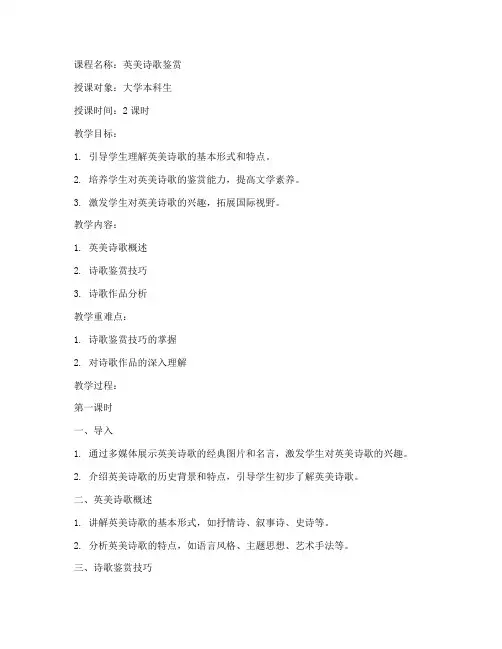
课程名称:英美诗歌鉴赏授课对象:大学本科生授课时间:2课时教学目标:1. 引导学生理解英美诗歌的基本形式和特点。
2. 培养学生对英美诗歌的鉴赏能力,提高文学素养。
3. 激发学生对英美诗歌的兴趣,拓展国际视野。
教学内容:1. 英美诗歌概述2. 诗歌鉴赏技巧3. 诗歌作品分析教学重难点:1. 诗歌鉴赏技巧的掌握2. 对诗歌作品的深入理解教学过程:第一课时一、导入1. 通过多媒体展示英美诗歌的经典图片和名言,激发学生对英美诗歌的兴趣。
2. 介绍英美诗歌的历史背景和特点,引导学生初步了解英美诗歌。
二、英美诗歌概述1. 讲解英美诗歌的基本形式,如抒情诗、叙事诗、史诗等。
2. 分析英美诗歌的特点,如语言风格、主题思想、艺术手法等。
三、诗歌鉴赏技巧1. 讲解如何分析诗歌的意象、象征、节奏、韵律等。
2. 通过实例分析,让学生掌握诗歌鉴赏的基本方法。
四、诗歌作品分析1. 选择一首英美诗歌作品,如莎士比亚的《十四行诗》、华兹华斯的《序曲》等。
2. 引导学生分析诗歌的意象、象征、节奏、韵律等,体会诗歌的意境和情感。
第二课时一、复习导入1. 回顾上节课所学内容,检查学生对英美诗歌的基本形式和特点的掌握情况。
2. 鼓励学生分享自己对诗歌的鉴赏心得。
二、诗歌作品分析1. 选择另一首英美诗歌作品,如济慈的《夜莺颂》、雪莱的《西风颂》等。
2. 引导学生分析诗歌的意象、象征、节奏、韵律等,体会诗歌的意境和情感。
三、课堂讨论1. 引导学生就诗歌作品展开讨论,分享自己的观点和感受。
2. 鼓励学生运用所学技巧对诗歌进行深入分析。
四、总结1. 总结本节课所学内容,强调诗歌鉴赏的重要性。
2. 布置课后作业,要求学生选取一首英美诗歌作品,进行鉴赏和分析。
教学评价:1. 课堂参与度:观察学生在课堂上的发言和互动情况。
2. 作业完成情况:检查学生课后作业的质量。
3. 诗歌鉴赏能力:通过课堂讨论和作业,评估学生对诗歌的鉴赏能力。
教学反思:1. 不断优化教学内容和教学方法,提高教学效果。

高中英语教案:诗歌欣赏和分析的英美文学导读引言嗨,同学们!今天我将带你们一起探索英美文学中的诗歌欣赏和分析。
诗歌是最为古老的文学形式之一,也是对语言艺术最高度的表达。
通过学习英美诗歌,我们可以感受到不同文化的独特之处,领略到诗人们的想象力和才华。
同时,通过分析诗歌,我们可以深入理解其中的隐含意义和艺术手法。
让我们从头开始,一起探索这个激动人心的领域吧!概述英美诗歌和其重要性英美诗歌自古希腊罗马时期起源,经过了几个世纪的演变和发展。
它不仅是文学的重要组成部分,而且是一种艺术形式,具有独特的音乐性、节奏感和韵律。
英美诗歌被广泛认为是人类思想和情感的最高表达,自然也在高中英语教学中占有重要地位。
诗歌欣赏的重要性以及教学目标诗歌欣赏是高中英语教学中不可或缺的一部分。
通过诗歌欣赏,我们可以培养学生的审美情趣、语言感知能力和文学修养。
此外,诗歌欣赏还可以帮助学生理解和体验不同文化背景下的情感和思想。
因此,在教学过程中,我们的目标应该是培养学生对诗歌的兴趣,提高他们的文学素养,并能够准确理解诗歌所传达的主题和情感。
诗歌分析的重要性以及教学目标诗歌分析是帮助学生深入理解诗歌的重要方法。
通过分析诗歌的形式、韵律、词汇以及隐含意义,学生可以更好地掌握诗歌的艺术特点和情感表达。
此外,诗歌分析还可以培养学生的思辨能力和独立思考能力。
因此,在教学过程中,我们的目标应该是帮助学生掌握诗歌分析的方法,培养他们的批判性思维和文学鉴赏能力。
诗歌欣赏与分析的教学方法为了有效地进行诗歌欣赏和分析的教学,我们需要采用多种教学方法来激发学生的兴趣和参与度。
以下是几种常见的教学方法:1. 内容导入以一个引人入胜的案例、故事或问题来引入诗歌,激发学生的兴趣和好奇心。
让学生在观察和思考的过程中逐渐接触到诗歌的魅力。
2. 朗读诗歌通过朗读诗歌,学生可以更好地感受到诗歌的音乐性和节奏感。
老师可以示范朗读,然后让学生跟读,体验诗歌中的语言韵律和情感表达。
大学英语诗歌教案教案标题:探索英语诗歌的美丽世界教案目标:1. 通过学习英语诗歌,培养学生对英语文学的兴趣和欣赏能力。
2. 帮助学生提高英语听说读写能力,特别是对韵律、押韵和修辞手法的理解和运用。
3. 培养学生对于诗歌的审美意识和创造力,鼓励他们尝试写作自己的英语诗歌。
教学重点:1. 了解英语诗歌的基本特点和形式。
2. 学习和欣赏经典英语诗歌。
3. 分析和理解诗歌中的韵律、押韵和修辞手法。
4. 提高学生的英语口语和写作能力。
教学准备:1. 大学英语课本和辅助教材,包括经典英语诗歌选集。
2. 录音设备和音频资料,用于朗读和听力训练。
3. 课堂展示材料,如投影仪、白板等。
教学过程:引入(5分钟):1. 利用音频资料播放一首经典英语诗歌,如William Wordsworth的《Daffodils》。
2. 向学生提问,引导他们谈论诗歌给他们带来的感受和印象。
导入(10分钟):1. 向学生介绍英语诗歌的基本特点和形式,如韵律、押韵和诗歌结构。
2. 分享一些著名的英语诗人和他们的作品,如Shakespeare、Robert Frost等。
3. 展示一些诗歌的例子,让学生感受和欣赏诗歌的美。
主体(30分钟):1. 学习和分析一首经典英语诗歌,如Robert Frost的《The Road Not Taken》。
a. 向学生介绍诗人和诗歌的背景。
b. 导读诗歌,帮助学生理解诗歌的意义和主题。
c. 分析诗歌中的韵律、押韵和修辞手法,如隐喻、比喻等。
d. 引导学生用自己的话解释诗歌的意义,并展开讨论。
2. 练习朗读和表演英语诗歌。
a. 分发一些简短的英语诗歌给学生。
b. 要求学生朗读和表演诗歌,注重发音、语调和情感的表达。
拓展(10分钟):1. 鼓励学生尝试写作自己的英语诗歌。
a. 提供一些写作诗歌的指导和提示。
b. 分组让学生互相交流和分享自己的作品。
总结(5分钟):1. 回顾本节课学到的知识和技能。
2. 强调诗歌的美和重要性。
教学目标:1. 通过学习诗歌《The Road Not Taken》,培养学生对英文诗歌的兴趣和欣赏能力。
2. 提高学生对诗歌节奏、韵律和意象的理解能力。
3. 培养学生运用英语进行诗歌创作的初步能力。
教学重点:1. 诗歌的节奏和韵律。
2. 诗歌的意象和象征意义。
3. 诗歌中的情感表达。
教学难点:1. 诗歌中抽象概念的理解。
2. 诗歌创作技巧的运用。
教学准备:1. 诗歌《The Road Not Taken》的文本。
2. 诗歌朗读录音。
3. 诗歌分析相关资料。
4. 学生创作的诗歌展示平台。
教学过程:一、导入1. 向学生介绍诗人罗伯特·弗罗斯特及其代表作品。
2. 提问:同学们有没有走过两条截然不同的路?有什么感受?3. 引导学生思考:诗歌是如何表达人生选择和决策的?二、诗歌分析1. 学生朗读诗歌,注意诗歌的节奏和韵律。
2. 教师讲解诗歌的结构和韵律特点。
3. 分析诗歌中的意象,如“two roads diverged in a yellow wood”和“the road less traveled by”。
4. 探讨诗歌中的象征意义,如人生选择和未知的未来。
三、诗歌创作1. 学生分组讨论,根据诗歌的主题和意象,创作自己的诗歌。
2. 教师提供创作技巧的指导,如运用比喻、象征等手法。
3. 学生展示自己的诗歌创作,全班进行点评和讨论。
四、总结与反思1. 教师总结诗歌《The Road Not Taken》的主要内容和艺术特点。
2. 学生分享自己在诗歌创作中的心得体会。
3. 引导学生思考:诗歌在人生选择中的作用。
五、作业布置1. 学生阅读其他英文诗歌,如《Stopping by Woods on a Snowy Evening》等,并分析其特点和象征意义。
2. 学生尝试创作一首以人生选择为主题的英文诗歌。
教学反思:1. 教师需关注学生对诗歌节奏和韵律的把握,通过朗读和音乐等方式进行强化。
2. 在诗歌创作环节,教师应鼓励学生发挥创意,勇于尝试不同的表达方式。
课程名称:英语诗歌欣赏课时:2课时年级:八年级教学目标:1. 让学生了解英文诗歌的基本特点,培养对英文诗歌的兴趣。
2. 提高学生的英语阅读能力和鉴赏能力。
3. 培养学生的审美情趣,激发学生的创造力。
教学重点:1. 英文诗歌的基本特点2. 英文诗歌的鉴赏方法教学难点:1. 英文诗歌的韵律和节奏2. 英文诗歌的情感表达教学准备:1. 教师准备:英文诗歌教材、PPT、多媒体设备2. 学生准备:预习相关英文诗歌,了解诗歌作者和背景教学过程:第一课时一、导入1. 教师通过PPT展示一些英文诗歌的图片,引导学生关注诗歌的美。
2. 提问:同学们,你们知道什么是诗歌吗?诗歌有哪些特点?二、新课导入1. 教师简要介绍英文诗歌的基本特点,如韵律、节奏、意象、情感等。
2. 分组讨论:让学生在小组内分享自己喜欢的英文诗歌,并分析诗歌的特点。
三、诗歌鉴赏1. 教师选取一首英文诗歌,让学生朗读并分析诗歌的韵律和节奏。
2. 引导学生关注诗歌中的意象和情感,分析作者的表达手法。
四、课堂小结1. 教师总结本节课的学习内容,强调英文诗歌的特点和鉴赏方法。
2. 学生分享自己的学习心得。
第二课时一、复习导入1. 教师提问:同学们,上一节课我们学习了英文诗歌的基本特点,那么你们还记得哪些呢?2. 学生回答,教师点评。
二、新课导入1. 教师展示一首新的英文诗歌,让学生朗读并分析诗歌的韵律和节奏。
2. 引导学生关注诗歌中的意象和情感,分析作者的表达手法。
三、拓展练习1. 教师布置课后作业,让学生选取一首自己喜欢的英文诗歌,分析其特点。
2. 课堂上,学生分享自己的作业,教师点评。
四、课堂小结1. 教师总结本节课的学习内容,强调英文诗歌的鉴赏方法。
2. 学生分享自己的学习心得。
教学反思:1. 本节课通过诗歌欣赏,让学生了解了英文诗歌的基本特点,提高了学生的英语阅读能力和鉴赏能力。
2. 在教学过程中,注重培养学生的审美情趣,激发学生的创造力。
3. 在今后的教学中,应继续关注学生的兴趣和需求,不断改进教学方法。
课程名称:大学英语诗歌鉴赏授课对象:大学英语专业二年级学生课时: 2课时教学目标:1. 通过诗歌鉴赏,提高学生的英语阅读理解能力。
2. 培养学生对英语诗歌的兴趣和鉴赏能力。
3. 增强学生的跨文化交际意识和情感表达能力。
教学内容:1. 诗歌背景介绍2. 诗歌内容分析3. 诗歌赏析与讨论4. 诗歌写作技巧分享教学重点:1. 诗歌内容的理解2. 诗歌情感的把握3. 诗歌结构的分析教学难点:1. 诗歌意象的解读2. 诗歌语言的艺术性分析3. 诗歌创作技巧的掌握教学准备:1. 诗歌文本2. 诗歌背景资料3. 相关图片或视频资料4. 白板或投影仪教学过程:第一课时一、导入(10分钟)- 以一首经典的英语诗歌开场,引导学生回顾诗歌的特点和结构。
- 提问:你们喜欢阅读诗歌吗?为什么?二、诗歌背景介绍(15分钟)- 介绍诗歌的作者、创作背景、诗歌所属流派等信息。
- 通过多媒体展示诗歌创作时期的图片或视频,帮助学生更好地理解诗歌的时代背景。
三、诗歌内容分析(20分钟)- 将学生分成小组,每组选择一首诗歌进行讨论和分析。
- 小组讨论结束后,每个小组派代表分享他们的分析结果。
四、诗歌赏析与讨论(20分钟)- 针对诗歌中的重点句子或意象进行深入分析,引导学生理解诗歌的深层含义。
- 引导学生讨论诗歌中的情感表达,以及作者如何通过语言和意象传达这些情感。
第二课时一、诗歌写作技巧分享(15分钟)- 邀请学生分享他们喜欢的英语诗歌,并分析诗歌的写作技巧。
- 讨论诗歌中的修辞手法、韵律、节奏等元素。
二、诗歌创作实践(20分钟)- 分配诗歌创作任务,让学生根据所学知识和讨论内容创作一首短诗。
- 学生创作完成后,进行互评和教师点评。
三、总结与反馈(10分钟)- 总结本节课的学习内容,强调诗歌鉴赏的重要性。
- 收集学生对课程的反馈,为后续教学提供参考。
教学评价:1. 学生对诗歌内容的理解程度。
2. 学生在诗歌赏析和讨论中的参与度和积极性。
课程名称:大学英语诗歌欣赏授课对象:大学一年级学生授课课时:2课时教学目标:1. 理解诗歌的基本形式和结构。
2. 培养学生对英语诗歌的兴趣和鉴赏能力。
3. 提高学生的英语阅读理解和表达能力。
4. 增强学生的跨文化意识和审美情趣。
教学重点:- 诗歌的主题和情感表达。
- 诗歌的修辞手法和韵律特点。
- 诗歌的文化背景和作者生平。
教学难点:- 诗歌中复杂情感的把握。
- 诗歌中修辞手法的运用分析。
教学准备:- 教学PPT或黑板。
- 诗歌文本材料。
- 相关文化背景资料。
教学过程:第一课时一、导入(10分钟)1. 以一段简短的英语诗歌朗诵作为导入,激发学生的学习兴趣。
2. 提问:What do you think of poetry? (诗歌是什么?)二、诗歌讲解(30分钟)1. 介绍诗歌的作者和创作背景。
2. 阅读诗歌,引导学生注意诗歌的结构、韵律和修辞手法。
3. 分析诗歌的主题和情感表达。
三、互动讨论(20分钟)1. 分组讨论:针对诗歌中的某个特定问题或情感,进行小组讨论。
2. 各小组汇报讨论结果,全班分享和交流。
四、课堂活动(20分钟)1. 模仿朗诵:选择一首诗歌,让学生进行模仿朗诵,感受诗歌的韵律。
2. 诗歌创作:鼓励学生尝试创作自己的诗歌,表达自己的情感和想法。
第二课时一、复习回顾(10分钟)1. 回顾上一节课的诗歌内容,检查学生的理解程度。
2. 提问:What did you learn from today's poetry? (你从今天的诗歌中学到了什么?)二、诗歌分析(30分钟)1. 深入分析诗歌中的修辞手法,如比喻、拟人、排比等。
2. 结合诗歌的文化背景,探讨诗歌的深层含义。
三、课堂展示(20分钟)1. 学生展示自己的诗歌创作,全班进行评价和反馈。
2. 教师点评学生的作品,给予鼓励和建议。
四、总结与作业布置(10分钟)1. 总结本节课的学习内容,强调诗歌欣赏的重要性。
2. 布置作业:阅读一首指定的英语诗歌,并撰写一篇鉴赏性评论。
教学目标:1. 让学生了解英语诗歌的基本特点,掌握诗歌的韵律和节奏。
2. 培养学生欣赏和欣赏英语诗歌的能力,提高他们的审美情趣。
3. 增强学生的英语口语表达能力,提高他们的语言运用能力。
教学重点:1. 英语诗歌的基本特点。
2. 诗歌的韵律和节奏。
3. 英语诗歌的朗读和表达。
教学难点:1. 诗歌的韵律和节奏。
2. 诗歌的朗读和表达。
教学过程:一、导入1. 向学生介绍英语诗歌的基本特点,激发他们的学习兴趣。
2. 播放一首经典的英语诗歌,让学生初步感受诗歌的韵律和节奏。
二、新课导入1. 介绍诗歌的韵律和节奏,让学生了解诗歌的基本结构。
2. 以一首简单的英语诗歌为例,讲解诗歌的韵律和节奏。
三、诗歌欣赏1. 分组让学生朗读一首英语诗歌,注意诗歌的韵律和节奏。
2. 学生分享自己的感受,教师点评。
四、诗歌创作1. 引导学生尝试创作自己的英语诗歌,要求注意韵律和节奏。
2. 学生展示自己的作品,教师点评。
五、总结与拓展1. 总结本节课所学内容,强调诗歌的韵律和节奏。
2. 布置课后作业,要求学生收集一首自己喜欢的英语诗歌,并尝试朗读和表达。
教学反思:1. 本节课通过欣赏、创作、朗读和表达等方式,让学生了解了英语诗歌的基本特点,提高了他们的审美情趣。
2. 在诗歌欣赏环节,学生的参与度较高,但在诗歌创作环节,部分学生表现出一定的困难。
教师应进一步引导学生,提高他们的创作能力。
3. 在诗歌朗读和表达环节,学生的表现较好,但在韵律和节奏方面还需加强训练。
教师应通过多种方式,提高学生的朗读和表达能力。
教学资源:1. 英语诗歌教材2. 英语诗歌音频资料3. 诗歌创作素材教学评价:1. 学生对英语诗歌的基本特点的了解程度。
2. 学生在诗歌欣赏、创作、朗读和表达等方面的表现。
3. 学生课后作业的完成情况。
英语诗歌的欣赏 精品资料 仅供学习与交流,如有侵权请联系网站删除 谢谢2 英语诗歌的欣赏
英诗浩瀚,篇幅长短不一,长至成集,短至几句。 本文从实用角度阐述英诗的欣赏:诗的格律、诗的押韵、诗的体式、诗的评判。 诗以高度凝结的语言表达着人们的喜怒哀乐,用其特有的节奏与方式影响着人们的精神世界。诗讲究联想,运用象征、比喻、拟人等各种修辞手法,形成了独特的语言艺术。 一、 诗的格律 “格律是指可以用脚打拍子的节奏”,是每个音步轻重音节排列的格式,也是朗读时轻重音的依据。而音步是由重读音节和非重读音节构成的诗的分析单位。重读音节为扬(重),在音节上用“-”或“ˊ”标示,非重读音节为抑(轻),在音节上用“︶”标示,音步之间可用“/”隔开。以下是五种常见格式: 1. 抑扬格(轻重格)Iambus:是最常见的一种格式,每个音步由一个非重读音节加一个重读音节构成。 As fair / art thou / my bon/nie lass, So deep / in luve / am I : And I / will luve / thee still,/ my dear, Till a` / the seas / gang dry: Robert Burns(1759-1796): My Luve Is like a Red, Red Rose 注;art=are luve=love bonnie=beautiful a`=all gang=go 精品资料 仅供学习与交流,如有侵权请联系网站删除 谢谢3 上例中为四音步与三音步交叉,可标示为:︶-/︶-/︶-/(︶-) 2.扬抑格(重轻格)Trochee:每个音步由一个重读音节加一个非重读音节构成。 下例中为四音步扬抑格(少一个轻音节),可标示为:-︶/-︶/-︶/- Tyger!/ Tyger!/ burning / bright In the / forests / of the / night William Blake: The Tyger 3. 抑抑扬格(轻轻重格)Anapaestic foot: 每个音步由两个非重读音节加一个重读音节构成。如:三音步抑抑扬格︶︶-/︶︶-/︶︶- Like a child / from the womb, Like a ghost / from the tomb, I arise / and unbuild / it again. 4. 扬抑抑格(重轻轻格)Dactylic foot: 每个音步由一个重读音节加两个非重读音节构成。如:两音步扬抑抑格-︶︶/-︶︶ ˊTouch her not / ˊscornfully, ˊThink of her / ˊmournfully. - Thomas Hood 精品资料 仅供学习与交流,如有侵权请联系网站删除 谢谢4 5. 抑扬抑格(轻重轻格)Amphibrach:每个音步由一个非重读音节加一个重读音节再加一个非重读音节构成。如:三音步抑扬抑格︶-︶/︶-︶/︶-︶下例中最后一个音步为抑扬格。 O ˊhush thee / my ˊbabie / thy ˊsire was / a knight. 在同一首诗中常会出现不同的格律,格律解析对朗读诗歌有一定参考价值。现代诗中常不遵守规范的格律。 二、 诗的押韵 押韵是指通过重复元音或辅音以达到一定音韵效果的诗歌写作手法。 1. 尾韵:最常见,最重要的押韵方式。 1) 联韵:aabb型。 I shot an arrow into the air, It fell to earth, I knew not where; For, so swiftly it flew, the sight Could not follow it in its flight. Henry Wadsworth Longfellow: The Arrow and the Song 2) 交叉韵:abab型。 Sunset and evening star, And one clear call for me! And may there be no moaning of the bar, When I put out to sea, Alfred Tennyson(1809-1892): Crossing the Bar 精品资料 仅供学习与交流,如有侵权请联系网站删除 谢谢5 3) 同韵:有的诗押韵,一韵到底,大多是在同一节诗中共用一个韵脚。 如下例就共用/i:p/为韵脚。 The woods are lovely, dark and deep, But I have promises to keep, And miles to go before I sleep, And miles to go before I sleep. Robert Frost (1874-1963): Stopping by Woods on a Snowy Evening 2. 头韵:是指一行(节)诗中几个词开头的辅音相同,形成押韵。下例中运用/f/、/b/与/s/头韵生动写出了船在海上轻快航行的景象。 The fair breeze blew, the white foam flew, The furrow followed free, We were the first that ever burst Into that silent sea. T.S. Coleridge: Rime of the Acient Mariner 3.内韵(同元音):指词与词之间原因的重复形成的内部押韵。 下面一节诗中/i/及/iη/重复照应,呈现出一派欢乐祥和的气氛。 Spring, the sweet spring, is the year‘s pleasant king; 精品资料 仅供学习与交流,如有侵权请联系网站删除 谢谢6 Then blooms each thing, then maids dance in a ring, Cold dath not sting, the pretty birds do sing: Cuckoo,jug-jug,pu-we,to-witta-woo! Thomas Nashe(1567-1601): Spring, the Sweet Spring 三、 诗的体式 有的诗分成几节(stanza),每节由若干诗行组成(每行诗均以大写字母开头);有的诗则不分节。目前我们常见的诗体有: 1.十四行诗(Sonnet),源于中世纪民间抒情短诗,十三、十四世纪流行于意大利,意大利彼特拉克(Petrarch)为代表人物,每行十一个音节,全诗一节八行,加一节六行,韵脚用abba, abba, cdcdcd (cdecde)。前八行提问,后六行回答。 后来,怀亚特(Thomas Wyatt,1503-1542)将十四行诗引人英国,五音步抑扬格,全诗三个四行一个二行,前三节提问,后二句结论。斯宾塞(Edmund Spenser,1552-1599)用韵脚 abab,bcbc,cdcd,ee。莎士比亚(William Shakespeare,1564-1616)用韵脚abab,cdcd,dfdf,gg,称英国式或莎士比亚式。举例见本文第四部分。 2.打油诗(Limericks):通常是小笑话甚至是胡诌,一般没有标题也无作者姓名,含有幽默讽刺性,常运用双关,内韵等手法。每首诗五个诗行,押韵为aabba,格律以抑扬格和抑抑扬格为主。 1) There was a young lady of Nigger Who smiled as she rode on a tiger; 精品资料 仅供学习与交流,如有侵权请联系网站删除 谢谢7 They returned from the ride With the lady inside, And the smile on the face of the tiger. 2) A tutor who taught on the flute Tried to teach two tooters to toot, “Is it harder to toot, or Said the two to the tutor, To tutor two tooters to toot?” 3.无韵体(Blank Verse):五音步抑扬格,不押韵诗体。 Across the watery bale, and shout again, Responsive to his call, -- with quivering peals, And long halloos, and screams, and echoes loud. Redoubled and redoubled: concourse wild Of jocund din!… William Wordsworth: There Was a Boy 4.自由诗(Free Verse):现代诗中常见的体式,长短不同的诗行存在于同一首诗中,不讲究押韵与格律,只注重诗歌所表达的意象和传递的情感。美国诗人Walt Whitman的《草叶集》(Leaves of Grass)中,就采用此格式。例子见第四部分。 四、诗的评判